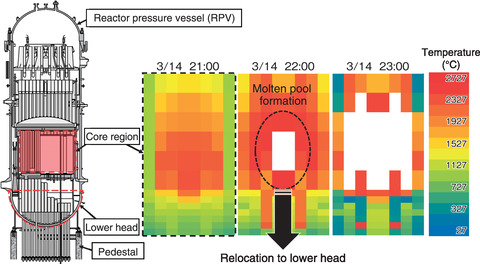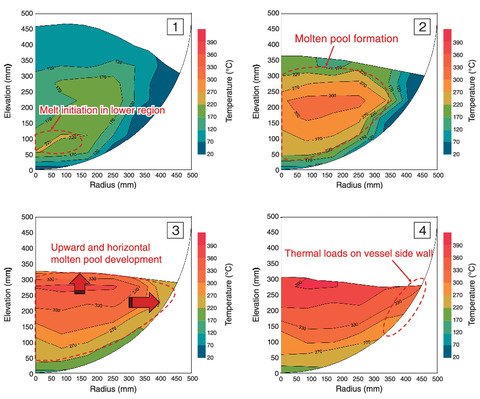
Fig.1-14 Estimated core temperature profile of Unit 2

Fig.1-15 Temperature profile in LIVE-J1 experiment*
The state of fuel debris and fission products deposited in the reactor pressure vessel (RPV) and primary containment vessel (PCV) must be understood for TEPCO's Fukushima Daiichi NPS (1F) decommissioning. As a result of internal investigations of the PCV of Unit 2, the state inside the pedestal, i.e., the cylindrical structure supporting the RPV, has become well understood. Since the structures inside the pedestal remain mostly intact, the temperature of the fuel debris relocated from the RPV to the pedestal inside is estimated to be lower than the melting temperature of oxidic nuclear fuel. According to conventional understanding, a high-temperature oxidic molten pool will be developed in the RPV lower head before the vessel failure (VF). However, recent investigations and numerical analyses have demonstrated that a mixed solid-liquid pool (i.e., where the oxidic components remain solid and only the metallic components are molten) was formed, and the local thermal load caused the VF.
Therefore, a severe accident (SA) analysis of Unit 2 of 1F was conducted, and the core materials relocated into the lower head were estimated to understand the 1F-specific VF mechanism. The calculated core temperature profile demonstrates that the core temperature reached a maximum of 2500 ℃ at 22:00, indicating the formation of a molten pool, as shown in Fig.1-14. The calculation results estimate that approximately 60% of the core inventory relocated to the lower head within the next several hours. Although the core debris must have moved to the pedestal inside due to VF, the location and mechanism of VF have not yet been identified.
Given that VF is caused by heat-up of the vessel walls, their temperature profiles are necessary to evaluate the failure modes. In collaboration with the LIVE facility at Karlsruhe Institute of Technology (KIT), we conducted an experiment to understand the heat transfer of debris comprising materials with various melting temperatures. Ceramics and nitrate salts were used to represent oxidic and metallic components of fuel debris, respectively. When compared with the 1F reactor, the test facility had a scale of 1:5.5. The simulated debris particles, comprising 245.4 kg of ceramics and 79.6 kg of nitrate salts, were preloaded in the test vessel. The decay heat was then simulated by the heating planes, where the boundary conditions of the top surface and sidewall were adiabatic and natural air convection, respectively. The resulting temperature evolution during the test is shown in Fig.1-15. Debris melting began from the lower region, and the molten pool developed both upwards and horizontally. This experiment showed that horizontal heat transfer occurs due to convection, even in a pool comprising a mixture of solid and liquid, and that the thermal loads on the vessel sidewall became large. Combining these results with numerical analysis will allow the failure mechanism of Unit 2 to be identified.
These results were obtained in part thanks to the cooperative research between JAEA and KIT.
(Hiroshi Madokoro)
* Madokoro, H. et al., LIVE Experiment on Thermal Behavior of Solid-Liquid Mixture Pool in RPV Lower Head, Atomic Energy Society of Japan 2021 Fall Meeting, online, 2021, 2J08 (in Japanese).